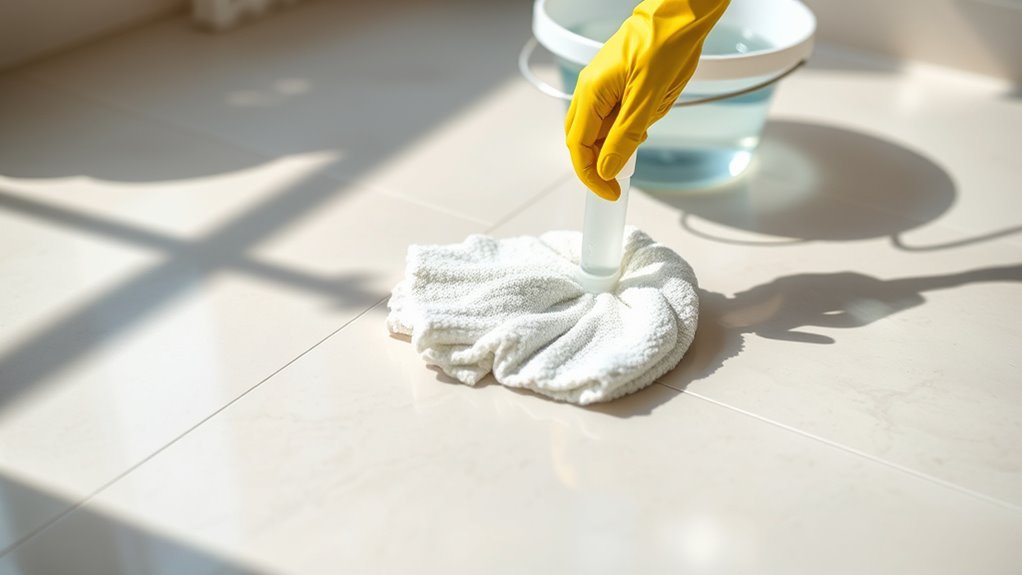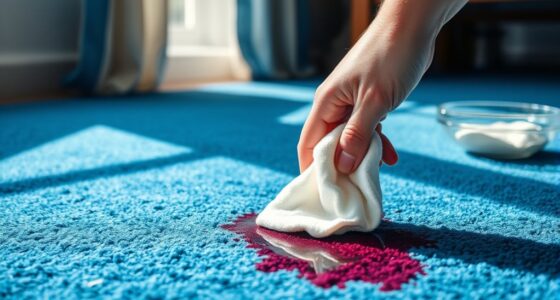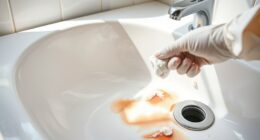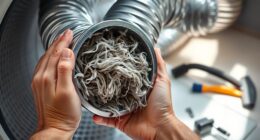To keep your tile floors shining and lasting longer, use a microfiber mop with a gentle, pH-balanced cleaner or mild dish soap. Sweep or vacuum first to remove loose dirt, then mop with overlapping strokes, avoiding over-wetting. Address stains promptly with baking soda paste or vinegar solutions, scrubbing gently. Regular maintenance and quick stain treatment help preserve the shine. Keep your floors looking their best—continue to discover more effective tips and tricks.
Key Takeaways
- Sweep or vacuum thoroughly to remove loose debris before mopping.
- Use a microfiber mop with a mild cleaning solution for gentle, effective cleaning.
- Clean stains immediately with appropriate solutions like baking soda paste or vinegar.
- Rinse the floor with clean water after mopping to remove residue and prevent streaks.
- Dry the tiles promptly with a microfiber cloth to enhance shine and prevent water spots.
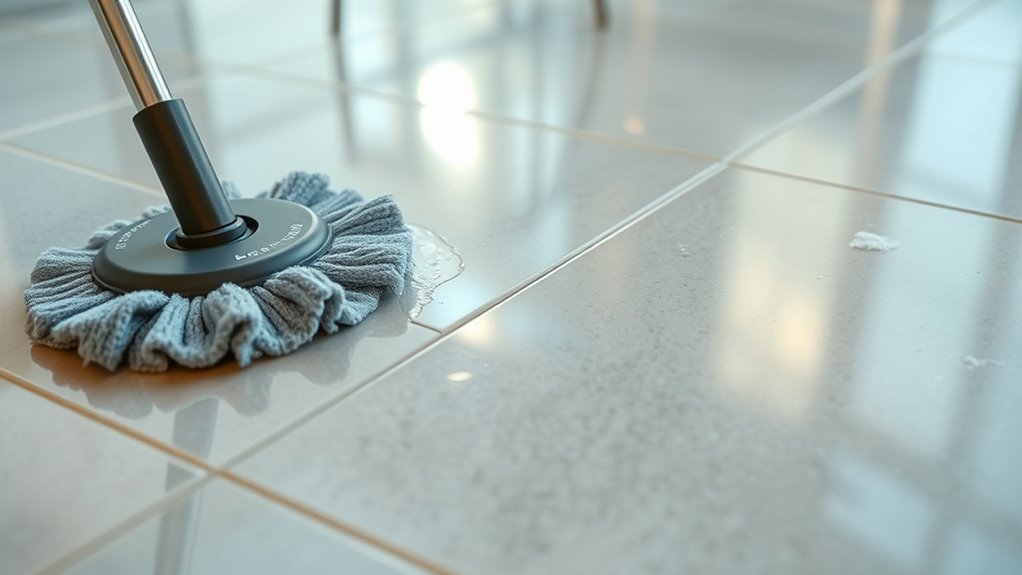
Have you ever wondered how to keep your tile floors looking spotless? Achieving a lasting shine isn’t just about occasional cleaning; it’s about mastering effective mop techniques and knowing how to handle stain removal. When you start with the right approach, your tiles will stay gleaming longer, and maintenance becomes much easier.
Begin by selecting the proper mop. A microfiber mop is your best option because it traps dirt and debris efficiently without scratching the surface. Before you start mopping, sweep or vacuum the floor thoroughly to remove loose dirt and grit, which can cause scratches during cleaning. When it’s time to mop, fill your bucket with warm water and add a gentle tile cleaner or a mix of mild dish soap. Dip your microfiber mop into the solution, then wring it out well. Excess water can leave streaks or cause grout to weaken, so avoid over-wetting the mop. Use smooth, overlapping strokes to clean the surface, making sure to cover every section of the floor. For stubborn spots or high-traffic areas, apply a little more pressure or use a soft-bristled brush to loosen grime.
Choose a microfiber mop and sweep thoroughly before cleaning for best results.
Stain removal is a vital part of maintaining your tile’s appearance. If you notice a stain, identify its cause—whether it’s dirt, grease, or mineral deposits—and target it specifically. For everyday stains, a paste made from baking soda and water often does the trick. Apply the paste directly onto the stain, let it sit for 10-15 minutes, then scrub gently with a soft brush or sponge. Rinse thoroughly with clean water and dry with a microfiber cloth to prevent new stains from setting. For tougher stains, like mold or mildew, a solution of equal parts white vinegar and water can be effective. Spray it onto the stain, let it sit for a few minutes, then scrub and rinse thoroughly. Additionally, automation in business is increasingly being adopted to improve efficiency and reduce manual labor, which can be beneficial for large cleaning operations.
Regular maintenance is key to keeping your tile floors looking their best. Incorporate routine mopping into your weekly cleaning schedule, and address stains immediately before they set in. Remember, the way you mop and how quickly you react to stains directly impact the durability and appearance of your tiles. With proper techniques and some simple stain removal tricks, your floors will remain beautiful and shiny for years to come.
Frequently Asked Questions
How Often Should I Deep Clean My Tile Floors?
You should deep clean your tile floors every 1 to 3 months, depending on foot traffic. Regular mopping frequency keeps dirt and grime at bay, preventing stains and buildup. By deep cleaning periodically, you not only maintain a lasting shine but also prevent stains from setting in. Consistent maintenance guarantees your tile floors look their best and stay durable over time. Adjust the schedule based on how busy your space gets.
What Are Natural Cleaning Alternatives for Tile Floors?
You can use eco-friendly solutions like a mixture of water and white vinegar for natural cleaning, but add a few drops of essential oils like tea tree or lavender for freshness. Alternatively, make a gentle scrub with baking soda and water. These natural alternatives effectively clean your tile floors without harsh chemicals, leaving them shiny and smelling great while being safe for your family and the environment.
Can I Use Vinegar on All Types of Tile?
You might think vinegar is a safe, natural cleaner, but beware—its risks vary with tile material. For ceramic and porcelain, vinegar usually works well without damage. However, for natural stone tiles like marble or limestone, vinegar can etch the surface and cause long-term harm. Always identify your tile type first, then decide if vinegar is the right choice, or if alternative cleaning methods are safer.
How Do I Remove Stubborn Grout Stains?
To remove stubborn grout stains, start with a grout stain removal solution like baking soda and hydrogen peroxide. Apply the paste to the stain and let it sit for 10-15 minutes. Use a stiff brush to scrub stubborn grout cleaning spots gently. Rinse with warm water and repeat if necessary. This method effectively tackles stubborn grout stains and keeps your tile floors looking fresh and clean.
Is It Safe to Use Bleach on Tile Floors?
Using bleach on tile floors can be safe if you follow proper bleach safety guidelines, but it’s important to be cautious. Bleach can cause tile damage or discoloration if used excessively or left on too long. Always dilute it properly, test a small area first, and make sure there is good ventilation. If unsure, opt for gentler cleaning solutions to maintain your tile’s shine without risking damage.
Conclusion
Now that you know the secrets to cleaning your tile floors, you can keep them gleaming like the halls of Olympus. Regular care and a few simple tricks will guarantee your floors remain as radiant as a sunlit sky. Think of your efforts as weaving a timeless tapestry—each clean tile adding to the masterpiece. With consistent upkeep, your floors will shine brilliantly, inviting admiration much like the legendary treasures of ancient tales.

